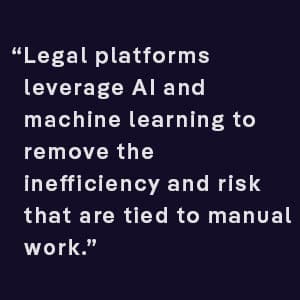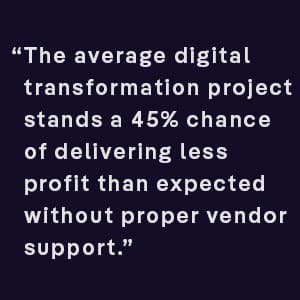Believe it or not, legal technology budgets are expected to increase threefold by 2025, according to Gartner. And within a couple of years, legal automation will likely support most of the tasks in corporate law departments. But embarking on a digital transformation journey still has its fair share of challenges, especially when it’s done without the right legal tech platform and vendor.
Fortunately, though, the latest legal tech platforms represent a single-product and -vendor approach to legal management. They provide robust features and advanced, end-to-end functionality that legal and other professionals need the most nowadays. And they are designed with in-house legal departments specifically in mind — but not exclusively.
Generally speaking, legal tech platforms leverage artificial intelligence (AI) and machine learning to remove the inefficiency and risk tied to manual work and provide valuable insight into processes, data, and workflows. They then help legal, and other professionals make more informed, strategic decisions for their departments and companies. Ultimately, when adopted and implemented properly, such systems create a solid foundation for legal digital transformation and automation — for the entire enterprise.
Here’s how.
An overabundance of Point Solutions
Today, the corporate legal team is no longer a “separate entity with isolated and siloed functions but a complementary body that coordinates their efforts to achieve the organization’s business objectives,” according to Law Technology Today.
Granted, the legal industry is not without individual point solutions. They each have noteworthy capabilities addressing a single aspect of legal practice. Think analytics and e-discovery. Although they help resolve specific issues in legal and other departments to some degree, these solutions can complicate legal matters. When implemented individually, these tools tend to allow for minimal sharing of data and documents, and typically generate disconnected workflows, as seen in the following:
- Data — distributed across multiple solutions — is not structured enough to provide timely answers to complex questions
- Siloed data does not support a proactive, strategic approach to legal and compliance management
- Collaboration and version control becomes problematic when documents are distributed among multiple systems
- Enforcement of best practices is challenging when a global team uses a variety of solutions
The Best Legal Tech Platform
The most reliable legal tech platform on the market protects legal and other departments far better than a collection of disparate, task-specific tools. It consolidates, centrally manages, and automates all legal, risk, and compliance data and processes. In particular, such a system succeeds in the following:
- Centralizing legal data and approved assets, like standard clauses and forms, in a single location
- Automating and standardizing legal processes, and reducing or eliminating the risk of manual errors and oversights
- Simplifying the user experience and increasing efficiency and data integrity
- Improving collaboration among internal departments and functions, external business partners, and across geographies
- Providing greater visibility and insight into legal and risk-related data and costs
- Delivering actionable insights that support better decision-making for more strategic, holistic, and proactive management of legal, risk, and compliance
Clearly, the benefits of unified legal platforms are becoming more apparent to legal and corporate leaders. But the best legal tech platforms on the market are designed for the way legal, and other professionals actually perform; are flexible, efficient, and secure; and allow customers to tailor their unique solutions. More specifically, they offer the following:
- Visionary, analyst-validated legal technology
- Partnerships with best-in-class technology companies
- Legal-led, comprehensive, end-to-end functionality (e.g., automated legal workflows, legal risk, and compliance, smart task manager, cognitive search, translation, etc.)
- Multidimensional or deep AI capabilities that further support and empower legal and other teams via increased impact and quicker time to value (Gartner and Forrester noted this AI approach as a clear differentiator for ContractPodAi versus other providers in the legal tech space.)
- Overall ease-of-use (e.g., multiple pre-configured or custom legal applications, which translate to less or no training for business users)
- High, no-code configurability translates into the easy configuration of workflows, approvals, document generation templates, compliance playbooks, and metadata fields
Legal-led Digital Transformations
According to McKinsey Quarterly, the average digital transformation project “stands a 45 percent chance of delivering less profit than expected” without proper vendor support. And the likelihood of surpassing profit expectations, on average, “is just one in ten.”
Providers of legal platforms, then, need to guide the digital transformation of in-house practices. They should allow customers to implement software with the very experts who conceived and built the technology in the first place. They should provide comprehensive services that span the entire transformation journey. This results in seamless transformations, with quicker rollouts, easier adoptions, greater impacts — and the highest possible returns on legal tech investments. In particular, the most reliable vendors offer the following:
- Scalability — Intuitive legal application builders help the system expand far beyond narrow point solutions
- Consultative teams — “Lawyers turned technologists” help deliver best practice transformation and change management (e.g., facilitate data migration, and present transformation overviews of customers’ legal functions, including a scorecard on their current digital state gaps and a blueprint for their future based on their desired business outcomes)
- No-cost deployment — Software implementations are provided with no extra costs
- Outcomes-based pricing — A percentage of annual subscription fees are based on desired business outcomes being met
- International help desk — Technical support is provided globally and in multiple languages
- Cost and time savings — Cost and time savings are supported across the entire workload — from contract management to corporate governance, compliance, M&A, and more — for overall customer success
Conclusion
As noted above, Gartner states that legal technology budgets will increase three times by 2025. Accordingly, automation will support more than 50 percent of legal services in the next few years. But Gartner also states that companies, which do not investigate their end-user needs and document their business requirements thoroughly, will only see about 30 percent of the benefits of legal management software. So, deploying a legal platform and undergoing a digital transformation should not be taken lightly or completed in haste.
For starters, it helps to know the four levels of legal digital transformation that legal departments and companies can reach over time. These common stages are be mapped by the ease of legal technology implementation against the legal tech’s value — or ROI — to customers. They involve contract digitization, which means all legal documents are stored in a single digital repository; legal automation, which provides end-to-end operational support for contracting; integration of artificial intelligence power; which offers analytic and strategic value to teams; and the transition toward a single legal platform; which expands the known value of legal software to processes across the enterprise. (For more on this, check out our white paper, “How to Choose a Contract Management Solution.”)
So, do you want to unify your legal processes and systems? Do you wish to increase the efficiency and effectiveness of legal and other departments? Download your copy of our latest paper, “Rise of the Legal Platform,” and find out everything you need to know about legal technology that is designed for the way you work today.
Author:
Atena Reyhani
Connect with us on LinkedIn










